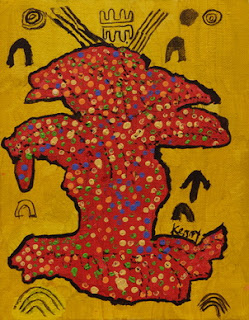Analogous Colours
An analogous colour
scheme/group makes everything seem the same colour at first until approached.
In general there are 3 colours in
a group. Together, they create a smooth
passage and bring harmony to your artwork.
There are two ways
of realising a passage when colouring or painting. You can use monochromatic colours (shades/ tones of
the same colour) or analogous colours.
Analogous colours are used by makeup artists, interior, product, graphic, fashion,
and flower designers as well.
Analogous colours
are colours that are adjacent to each other on the colour wheel, with one being
the dominant colour. The dominant colour
can be either primary, or secondary.
Orange,
yellow-orange and yellow is a group of analogous colours. The dominant colour
in this group is yellow, because orange and orange-yellow contain yellow. They
are blended nicely in “Sunflowers”, a painting by Vincent Van Gogh.
To make a group of analogous colours, pick one colour, and then go
either to the right or to the left of the colour wheel, to choose the other 2
colours. Imagine the colour wheel as a clock. Number 12 is yellow and number
six is violet. For the best results make sure you have in your group a
primary colour, a secondary colour and a tertiary colour.
A tertiary color is a colour made by mixing one primary
color with a secondary color (red-orange, yellow-green, blue-violet, etc)
Analogous groups of
colours are best used with either warm or cool colours.
Your group can also
contain a warm colour and two cool colours. It cannot contain two
warm colours and one cool colour.
Possible groups of
analogous colours when going to the right on the colour wheel:
yellow, yellow-orange, orange ( all three colours are warm
colours, the dominant is yellow)
Orange, red
orange, red (all three colours are _________ colours, the dominant is
___________ )
Red,
red-violet, violet (one colour is ________, the other two are _______. The
dominant is ___________)
Violet, blue-violet, blue (all three colours are ________,
the dominant is _________)
Blue, blue-green, green (all three colours are ______, the
dominant is ___________)
Green, yellow-green, yellow (one colour is ________, the
other two are _______. The dominant is ________)
You are going to have the same results if going to the left
on the colour wheel. Try it!
You cannot
go to the left and to the right of your chosen colour. If you do, you will have
two warm colours and one cool colour in your group.
For example, yellow, yellow-green and orange is an incorrect
analogous colour scheme. Yellow –green flows from yellow. They are part of the
same family, but yellow-orange contains red, so it is not related to the first
two colours of your group.
There can also be 4
colours in a group of analogous colours. The pattern to follow when making a group of 4 analogous colours is:
primary colour, tertiary colour,
secondary colour and tertiary colour. All your four colours should be either
warm, or cool. You can also have one warm colour and three cool.
Examples:
yellow, yellow-green, green and blue-green. (the dominant
colour in this group is blue)
blue, blue-violet, violet, red-violet ( the dominant colour
in this group is blue)
red, red-orange, orange, yellow- orange ( the dominant
colour in this group is red)
.JPG)
.JPG)
.JPG)




















